Related Research Articles

Forensic entomology is the scientific study of the colonization of a dead body by arthropods. This includes the study of insect types commonly associated with cadavers, their respective life cycles, their ecological presences in a given environment, as well as the changes in insect assemblage with the progression of decomposition. Insect succession patterns are identified based on the time a given species of insect spends in a given developmental stage, and how many generations have been produced since the insects introduction to a given food source. Insect development alongside environmental data such as temperature and vapor density, can be used to estimate the time since death, due to the fact that flying insects are attracted to a body immediately after death. The identification of postmortem interval to aid in death investigations is the primary scope of this scientific field. However, forensic entomology is not limited to homicides, it has also been used in cases of neglect and abuse, in toxicology contexts to detect the presence of drugs, and in dry shelf food contamination incidents. Equally, insect assemblages present on a body, can be used to approximate a given location, as certain insects may be unique to certain areas. Therefore, forensic entomology can be divided into three subfields: urban, stored-product and medico-legal/medico-criminal entomology.

Flies are insects of the order Diptera, the name being derived from the Greek δι- di- "two", and πτερόν pteron "wing". Insects of this order use only a single pair of wings to fly, the hindwings having evolved into advanced mechanosensory organs known as halteres, which act as high-speed sensors of rotational movement and allow dipterans to perform advanced aerobatics. Diptera is a large order containing an estimated 1,000,000 species including horse-flies, crane flies, hoverflies, mosquitoes and others, although only about 125,000 species have been described.

Offal, also called variety meats, pluck or organ meats, is the internal organs of a butchered animal. The word does not refer to a particular list of edible organs, and these lists of organs vary with culture and region, but usually exclude skeletal muscle. Offal may also refer to the by-products of milled grains, such as corn or wheat.

A maggot is the larva of a fly ; it is applied in particular to the larvae of Brachycera flies, such as houseflies, cheese flies, and blowflies, rather than larvae of the Nematocera, such as mosquitoes and crane flies.

A meat alternative or meat substitute, is a food product made from vegetarian or vegan ingredients, eaten as a replacement for meat. Meat alternatives typically approximate qualities of specific types of meat, such as mouthfeel, flavor, appearance, or chemical characteristics. Plant- and fungus-based substitutes are frequently made with soy, but may also be made from wheat gluten as in seitan, pea protein as in the Beyond Burger, or mycoprotein as in Quorn.

The Calliphoridae are a family of insects in the order Diptera, with almost 1,900 known species. The maggot larvae, often used as fishing bait, are known as gentles. The family is known to be polyphyletic, but much remains disputed regarding proper treatment of the constituent taxa, some of which are occasionally accorded family status.

Fodder, also called provender, is any agricultural foodstuff used specifically to feed domesticated livestock, such as cattle, rabbits, sheep, horses, chickens and pigs. "Fodder" refers particularly to food given to the animals, rather than that which they forage for themselves. Fodder includes hay, straw, silage, compressed and pelleted feeds, oils and mixed rations, and sprouted grains and legumes. Most animal feed is from plants, but some manufacturers add ingredients to processed feeds that are of animal origin.

The apple maggot, also known as the railroad worm, is a species of fruit fly, and a pest of several types of fruits, especially apples. This species evolved about 150 years ago through a sympatric shift from the native host hawthorn to the domesticated apple species Malus domestica in the northeastern United States. This fly is believed to have been accidentally spread to the western United States from the endemic eastern United States region through contaminated apples at multiple points throughout the 20th century. The apple maggot uses Batesian mimicry as a method of defense, with coloration resembling that of the forelegs and pedipalps of a jumping spider.

Myiasis, also known as flystrike or fly strike, is the parasitic infestation of the body of a live animal by fly larvae (maggots) that grow inside the host while feeding on its tissue. Although flies are most commonly attracted to open wounds and urine- or feces-soaked fur, some species can create an infestation even on unbroken skin and have been known to use moist soil and non-myiatic flies as vector agents for their parasitic larvae.
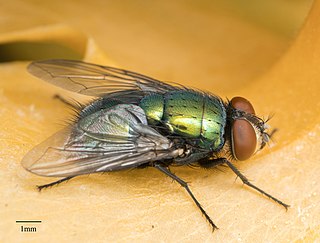
The common green bottle fly is a blowfly found in most areas of the world and is the most well-known of the numerous green bottle fly species. Its body is 10–14 mm (0.39–0.55 in) in length – slightly larger than a house fly – and has brilliant, metallic, blue-green or golden coloration with black markings. It has short, sparse, black bristles (setae) and three cross-grooves on the thorax. The wings are clear with light brown veins, and the legs and antennae are black. The larvae of the fly may be used for maggot therapy, are commonly used in forensic entomology, and can be the cause of myiasis in livestock and pets. The common green bottle fly emerges in the spring for mating.

Chumming is the blue water fishing practice of throwing meat-based groundbait called "chum" into the water in order to lure various marine animals to a designated fishing ground, so the target animals are more easily caught by hooking or spearing. Chums typically consist of fresh chunks of fish meat with bone and blood, the scent of which attracts predatory fish, particularly sharks, billfishes, tunas and groupers. In the past, the chum contents have also been made from "offal", the otherwise rejected or unwanted parts of slaughtered animals such as internal organs.
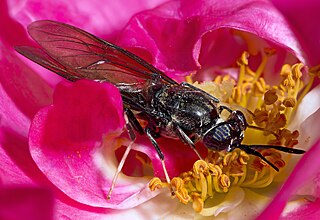
Hermetia illucens, the black soldier fly, is a common and widespread fly of the family Stratiomyidae. Since the late 20th century, H. illucens has increasingly been gaining attention because of its usefulness for recycling organic waste and generating animal feed.
In animal husbandry, feed conversion ratio (FCR) or feed conversion rate is a ratio or rate measuring of the efficiency with which the bodies of livestock convert animal feed into the desired output. For dairy cows, for example, the output is milk, whereas in animals raised for meat the output is the flesh, that is, the body mass gained by the animal, represented either in the final mass of the animal or the mass of the dressed output. FCR is the mass of the input divided by the output. In some sectors, feed efficiency, which is the output divided by the input, is used. These concepts are also closely related to efficiency of conversion of ingested foods (ECI).

Cochliomyia is a genus in the family Calliphoridae, known as blowflies, in the order Diptera. Cochliomyia is commonly referred to as the New World screwworm flies, as distinct from Old World screwworm flies. Four species are in this genus: C. macellaria, C. hominivorax, C. aldrichi, and C. minima. C. hominivorax is known as the primary screwworm because its larvae produce myiasis and feed on living tissue. This feeding causes deep, pocket-like lesions in the skin, which can be very damaging to the animal host. C. macellaria is known as the secondary screwworm because its larvae produce myiasis, but feed only on necrotic tissue. Both C. hominivorax and C. macellaria thrive in warm, tropical areas.
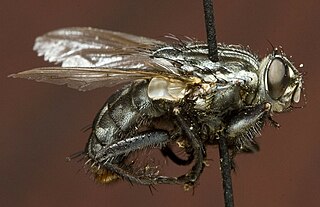
Sarcophaga bullata, or the grey flesh fly, is a species of fly belonging to the family Sarcophagidae. It varies in size from small to large, 8 to 17 millimeters in length and is very similar in appearance and behavior to a closely related species, Sarcophaga haemorrhoidalis. S. bullata is a common scavenger species in the Eastern United States, but is found throughout the Nearctic region. Identification down to the species level in the family Sarcophagidae is notably difficult and relies primarily on the male genitalia. Though limited information is available regarding S. bullata, it has gained increasing recognition in the field of forensic entomology as a forensically relevant fly species, as it may be among the first species to colonize human remains. In these instances, recovered maggots may be analyzed for post-mortem interval (PMI) estimations, which may be used as evidence in courts of law. Current studies regarding S. bullata have revealed a maternal effect operating in these flies that prevents pupal diapause under certain environmental conditions, which is an important factor to be considered during forensic analyses.
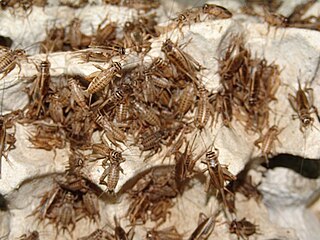
Insect farming is the practice of raising and breeding insects as livestock, also referred to as minilivestock or micro stock. Insects may be farmed for the commodities they produce, or for them themselves; to be used as food, as feed, as a dye, and otherwise.
Insect-based pet food is pet food consisting of, or containing insects digestible by pets such as dogs or cats. A limited, but growing number of products are available on the market, including insect-based cat food, dog food, and pet treats.
AgriProtein is a British agricultural and biotechnology company that uses insects to convert food waste into sustainable products including: an alternative protein for use in livestock and aquaculture feed, a natural oil for use in animal feed, and an organic soil enhancer. The company was founded in 2008 in South Africa. AgriProtein is a subsidiary of the Insect Technology Group.
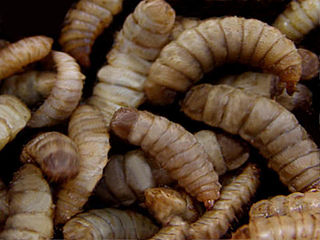
Insects as feed are insect species used as animal feed, either for livestock, including aquaculture, or as pet food.
References
- ↑ "Nutritional Value Of Black Soldier Fly Larvae". Kimmy Farm Vietnam.
- ↑ The Blue Economy: 10 years – 100 innovations – 100 million jobs by Gunther Pauli
- ↑ Briar, Graham (May 22, 2017). "Building a Maggot Farm". www.youtube.com.
- ↑ "How One South African Entrepreneur Hopes to Make Millions From Maggots". Time.
- ↑ "BSF Uses - BSF Farming". www.blacksoldierflyfarming.com.
- 1 2 "Leading Maggot Farmer to Expand From Cape Town to California". Bloomberg.com. 2019-10-31. Retrieved 2020-11-29.